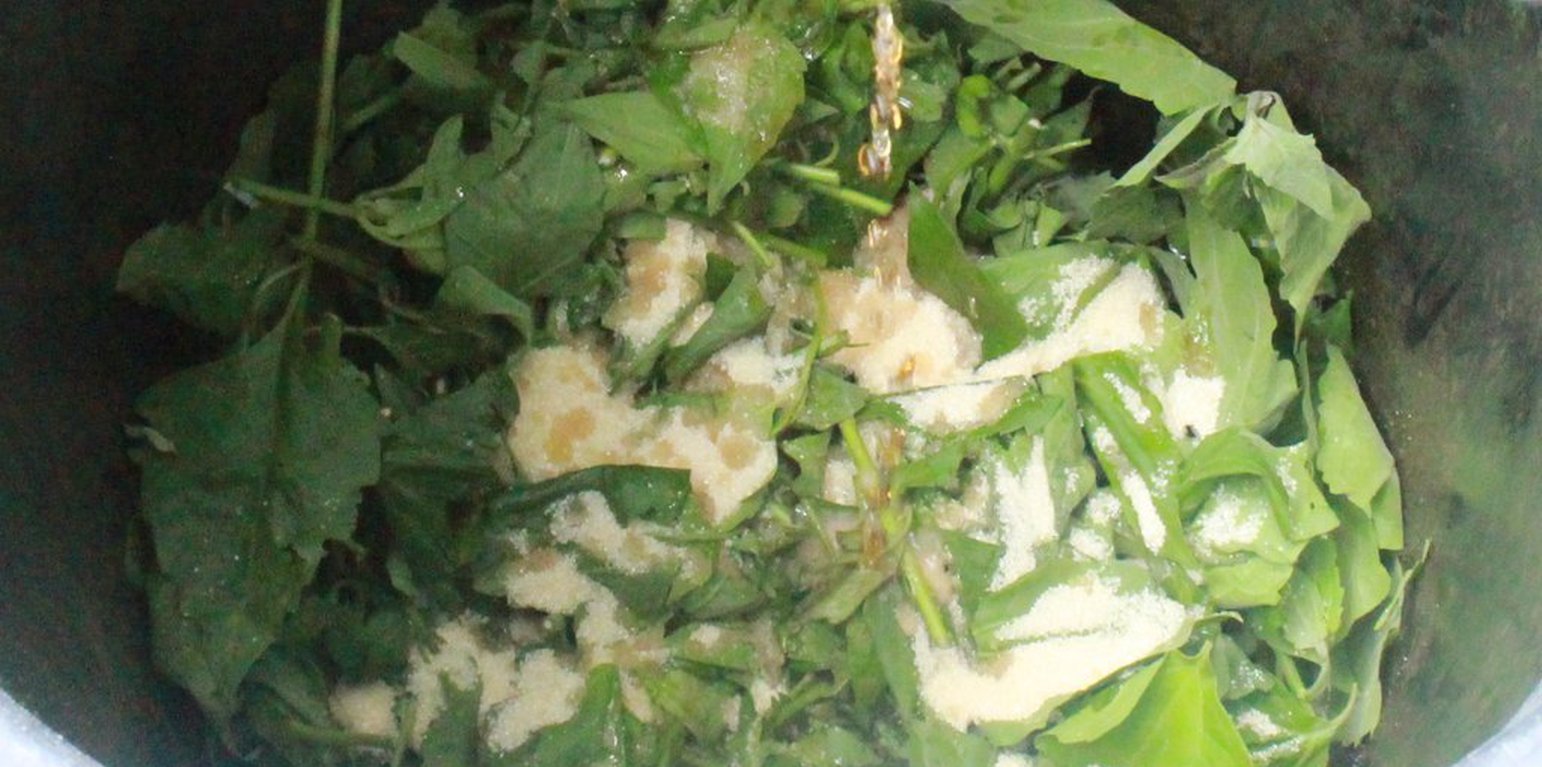Use of Effective Micro-organism (EM) to improve soil fertility in vegetable home gardens
(República Democrática Popular do Laos)
Descrição
Effective micro-organism (EM) is a liquid concentrate which can be used as a pre planting treatment, for actively growing vegetables and helps to increase beneficial soil microorganisms and suppression of harmful ones.
Farmers have practiced household gardening for a considerable period of time in order to increase food security and generate an income. However some farmers have experienced difficulties in cultivating vegetables due to various challenges such as the soil type, for example clay or compacted soil, ineffective water seepage as well as the soil’s low nutrient content making it unsuitable for agricultural purposes. Consequently, the problems that the farmers often faced included vegetables of inferior quality, outbreaks of diseases, as well as surges of insects and pests which typically reduce yields by approximately 30%. In order to increase production and cultivate at a preferable period of time, farmers often applied chemical fertilizer in combination with animal compost. However the production outputs and quality of the produce were not up to expectations if compared to agricultural practices that do not involve the use of chemicals. It has been noted that vegetables grown with the use of chemical fertilizers cannot be kept for a long period of time as they tend to spoil more quickly, despite the increase in production yields. In 2015 an International Fund for Agriculture Development (IFAD) Programme introduced a technique to produce effective micro-organisms (EM) and encouraged people to use these to improve the nutrient content of the soil and thereby enhance the quality of home garden vegetables as well as other potential crops. The farmers gained an interest in EM and began to produce it according to the programme’s instructions. The production of EM is actually relatively easy, and farmers can use organic waste from vegetables such as Chinese mustard (Brassica juncea), morning glory and water spinach mixed with 1kg of sugar and 0.5 kg of molasses (if available, or it can be excluded, but it should be available at an agricultural produce outlet). Firstly the organic waste should be sliced/chopped into small pieces and then sugar and molasses are added which are then all mixed in a 20 litre container. Then a one metre long stick should be used to mix all the ingredients and the container lid should then be sealed properly. Once these steps have been completed, the EM production container should avoid sunlight and be stored in the shade so as to ensure the quality of EM. After one week the container can be opened to mix the ingredients again and then it can continue to remain in the shade for another month. Thereafter, EM mixture is ready for use and one table spoon should be added to 10 litres of water, and once this has been mixed well it can be applied to the vegetables in the home garden by using water cans. Watering involves pouring the solution from the leaves to the stems or to the roots of the vegetables. After the application of the EM solution it was noted that there were more earthworms around the vegetable plots and also that there was an increase in soil moisture and nutrients. Furthermore it was also noted that the soil was previously relatively white and compacted and not black and porous allowing for good water seepage. In this way water is absorbed by the soil in the plot rather than running off over the surface. Plant pathogens and pests/insects such as red ants and leaf worms was reduced. As a result, the vegetables grew well with a good average weight, and there was an increase in both the quality and the yield. As a comparison, in the past farmers used to be able to harvest 5-6 kg per plot, but now they are capable of securing 12-15kg per plot. However, weeds still remain a problem and these include Eleusine indica and thorny grass which compete for nutrients with the crops. It is a challenge for the farmers to control these weeds including other natural vegetables.
Localização
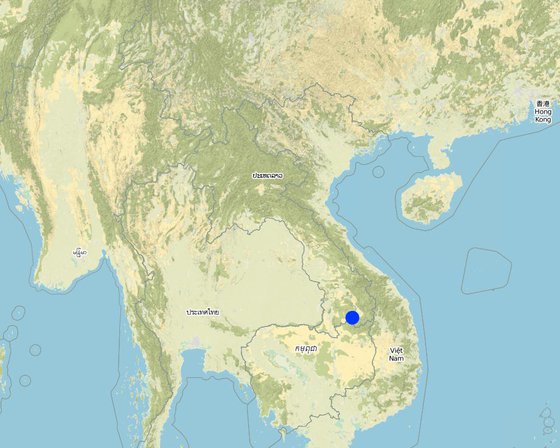
Localização: Phouvong district,, Attapeu province, República Democrática Popular do Laos
Nº de sites de tecnologia analisados: Local único
Geo-referência de locais selecionados
Difusão da tecnologia: Uniformemente difundida numa área (approx. < 0,1 km2 (10 ha))
Data da implementação: 2015; menos de 10 anos atrás (recentemente)
Tipo de introdução
-
atráves de inovação dos usuários da terra
-
Como parte do sistema tradicional (>50 anos)
-
durante experiências/ pesquisa
-
através de projetos/intervenções externas
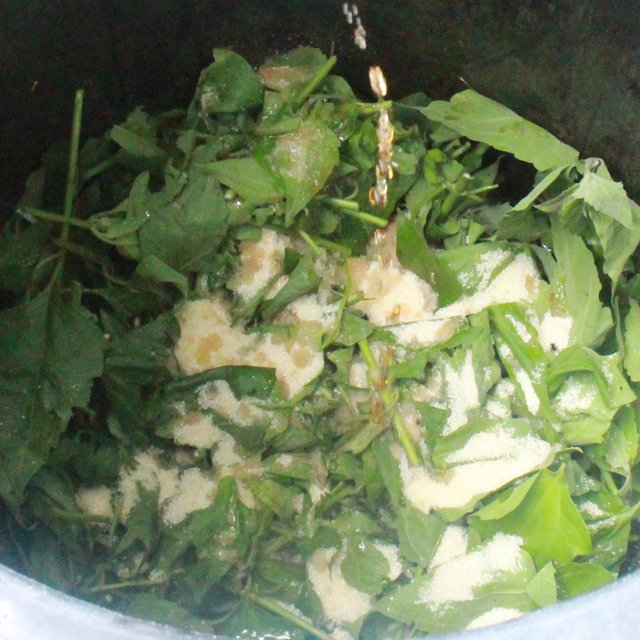
Waste from vegetable, sugar, and molasses (Phonesyli phanvongsa)
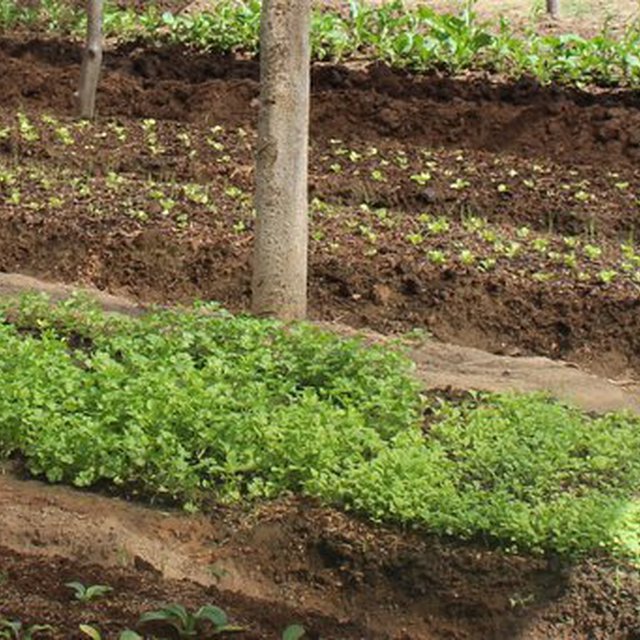
Vegetable garden plot where the EM solution is applied to improve soil fertility and increase crop yields (Phonesyli phanvongsa)
Classificação da Tecnologia
Objetivo principal
-
Melhora a produção
-
Reduz, previne, recupera a degradação do solo
-
Preserva ecossistema
-
Protege uma bacia/zonas a jusante – em combinação com outra tecnologia
-
Preservar/melhorar a biodiversidade
-
Reduzir riscos de desastre
-
Adaptar a mudanças climáticas/extremos e seus impactos
-
Atenuar a mudanças climáticas e seus impactos
-
Criar impacto econômico benéfico
-
Cria impacto social benéfico
Uso da terra
-
Terra de cultivo - Cultura anual
Principais plantações (colheitas para venda e consumo próprio): Peppermint, Lettuce, Chinese Kale, Sweet Basil
Abastecimento de água
-
Precipitação natural
-
Misto de precipitação natural-irrigado
-
Irrigação completa
Número de estações de cultivo por ano:
2
Uso do solo antes da implementação da Tecnologia:
n.a.
Densidade pecuária:
n.a.
Objetivo relacionado à degradação da terra
-
Prevenir degradação do solo
-
Reduzir a degradação do solo
-
Recuperar/reabilitar solo severamente degradado
-
Adaptar à degradação do solo
-
Não aplicável
Degradação abordada
-
Deteriorização química do solo - Cn: declínio de fertilidade e teor reduzido de matéria orgânica (não causado pela erosão)
-
Degradação biológica - Bh: perda dos habitats, Bs: Qualidade e composição de espécies/declínio de diversidade
Grupo de GST
-
Gestão integrada de fertilidade do solo
-
Hortas familiares
Medidas de GST
-
Medidas agronômicas - A2: Matéria orgânica/fertilidade do solo
Desenho técnico
Especificações técnicas
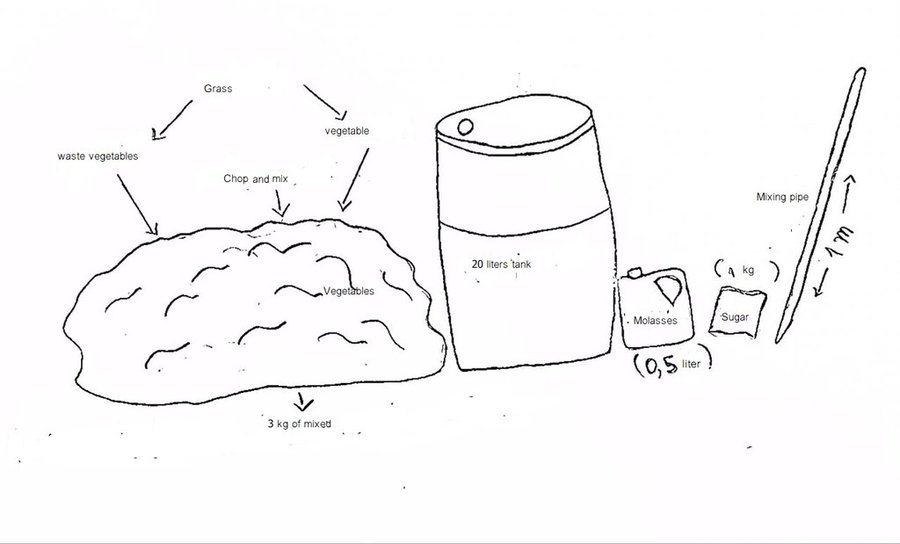
Autor: Fadavanh Souliya
This bio-extracting technique can be done easily and farmers can use local waste materials such as cabbage, pineapple, spinach and so on. With the following ingredients: 3 kg of vegetables, 1 kg of sugar, 0.5 liters of molasses. Then bring the vegetables to chop thoroughly and then bring the sugar and mixed molasses into a 20 liter tank prepared and mixed together, the area of the bio-extracted technique is 2 meters x 2 meters, Then put about 1 meter of wood to mix it and close the barrel to keep it in the air when practicing all the techniques and then we will bring a bio-extracted tank to a sunny shade to preserve the quality of detergent, Then one more week, we can open the tank for all the ingredients again, so we can do this for a period of time, up to a month, and then add the biological extracts 1 spoon / 10 liters of water to mix and then irrigate the vegetable.
Estabelecimento e manutenção: atividades, insumos e custos
Cálculo de insumos e custos
- Os custos são calculados: por área de tecnologia
- Moeda utilizada para o cálculo de custos: Kip
- Taxa de câmbio (para USD): 1 USD = 8500.0 Kip
- Custo salarial médio da mão-de-obra contratada por dia: 50000
Fatores mais importantes que afetam os custos
Labor
Atividades de implantação
-
Collect the waste vegetable (Periodicidade/frequência: After harvesting)
-
chop to small size (Periodicidade/frequência: After harvesting)
-
Mix with sugar and molasses (Periodicidade/frequência: None)
-
Irrigate vegetable (Periodicidade/frequência: None)
Estabelecer insumos e custos
| Especifique a entrada |
Unidade |
Quantidade |
Custos por unidade (Kip) |
Custos totais por entrada (Kip) |
% dos custos arcados pelos usuários da terra |
|
Mão-de-obra
|
| Labor |
person |
1,0 |
50000,0 |
50000,0 |
100,0 |
|
Equipamento
|
| Knife |
peice |
1,0 |
20000,0 |
20000,0 |
|
| irrigation tank |
peice |
1,0 |
30000,0 |
30000,0 |
|
| Bucket |
peice |
2,0 |
25000,0 |
50000,0 |
|
|
Material vegetal
|
| Molasses |
kg |
1,0 |
8000,0 |
8000,0 |
100,0 |
| Sugar |
liter |
2,0 |
7000,0 |
14000,0 |
100,0 |
| Custos totais para a implantação da tecnologia |
172'000.0 |
|
Atividades de manutenção
-
Collect the waste vegetable (Periodicidade/frequência: After harvesting)
-
chop to small size (Periodicidade/frequência: After harvesting)
-
Mix with sugar and molasses (Periodicidade/frequência: None)
-
Irrigate vegetable (Periodicidade/frequência: None)
Insumos e custos de manutenção
| Especifique a entrada |
Unidade |
Quantidade |
Custos por unidade (Kip) |
Custos totais por entrada (Kip) |
% dos custos arcados pelos usuários da terra |
|
Mão-de-obra
|
| Labor |
person |
1,0 |
50000,0 |
50000,0 |
100,0 |
|
Equipamento
|
| Knife |
piece |
1,0 |
20000,0 |
20000,0 |
|
| irrigation tank |
piece |
1,0 |
30000,0 |
30000,0 |
|
| tank |
piece |
1,0 |
25000,0 |
25000,0 |
|
|
Material vegetal
|
| Molasses |
kg |
1,0 |
7000,0 |
7000,0 |
100,0 |
| Sugar |
liter |
2,0 |
8000,0 |
16000,0 |
100,0 |
| Custos totais para a manutenção da tecnologia |
148'000.0 |
|
Ambiente natural
Média pluviométrica anual
-
<250 mm
-
251-500 mm
-
501-750 mm
-
751-1.000 mm
-
1.001-1.500 mm
-
1.501-2.000 mm
-
2.001-3.000 mm
-
3.001-4.000 mm
-
> 4.000 mm
Zona agroclimática
-
úmido
-
Subúmido
-
Semiárido
-
Árido
Especificações sobre o clima
Pluviosidade média anual em mm: 2500.0
Between November and April, rainfall is about 20 - 80 mm
From May to October rain started to fall about 200-500 mm, much rainfall before the first, from June to October.
Nome da estação meteorológica: Climatology Department of Phouvong District
Inclinação
-
Plano (0-2%)
-
Suave ondulado (3-5%)
-
Ondulado (6-10%)
-
Moderadamente ondulado (11-15%)
-
Forte ondulado (16-30%)
-
Montanhoso (31-60%)
-
Escarpado (>60%)
Formas de relevo
-
Planalto/planície
-
Cumes
-
Encosta de serra
-
Encosta de morro
-
Sopés
-
Fundos de vale
Altitude
-
0-100 m s.n.m.
-
101-500 m s.n.m.
-
501-1.000 m s.n.m.
-
1.001-1.500 m s.n.m.
-
1.501-2.000 m s.n.m.
-
2.001-2.500 m s.n.m.
-
2.501-3.000 m s.n.m.
-
3.001-4.000 m s.n.m.
-
> 4.000 m s.n.m.
A tecnologia é aplicada em
-
Posições convexas
-
Posições côncavas
-
Não relevante
Profundidade do solo
-
Muito raso (0-20 cm)
-
Raso (21-50 cm)
-
Moderadamente profundo (51-80 cm)
-
Profundo (81-120 cm)
-
Muito profundo (>120 cm)
Textura do solo (superficial)
-
Grosso/fino (arenoso)
-
Médio (limoso, siltoso)
-
Fino/pesado (argila)
Textura do solo (>20 cm abaixo da superfície)
-
Grosso/fino (arenoso)
-
Médio (limoso, siltoso)
-
Fino/pesado (argila)
Teor de matéria orgânica do solo superior
-
Alto (>3%)
-
Médio (1-3%)
-
Baixo (<1%)
Lençol freático
-
Na superfície
-
< 5 m
-
5-50 m
-
> 50 m
Disponibilidade de água de superfície
-
Excesso
-
Bom
-
Médio
-
Precário/nenhum
Qualidade da água (não tratada)
-
Água potável boa
-
Água potável precária (tratamento necessário)
-
apenas para uso agrícola (irrigação)
-
Inutilizável
A salinidade é um problema?
Ocorrência de enchentes
Características dos usuários da terra que utilizam a tecnologia
Orientação de mercado
-
Subsistência (autoabastecimento)
-
Misto (subsistência/comercial)
-
Comercial/mercado
Rendimento não agrícola
-
Menos de 10% de toda renda
-
10-50% de toda renda
-
>50% de toda renda
Nível relativo de riqueza
-
Muito pobre
-
Pobre
-
Média
-
Rico
-
Muito rico
Nível de mecanização
-
Trabalho manual
-
Tração animal
-
Mecanizado/motorizado
Sedentário ou nômade
-
Sedentário
-
Semi-nômade
-
Nômade
Indivíduos ou grupos
-
Indivíduo/unidade familiar
-
Grupos/comunidade
-
Cooperativa
-
Empregado (empresa, governo)
Idade
-
Crianças
-
Jovens
-
meia-idade
-
idosos
Área utilizada por residência
-
< 0,5 ha
-
0,5-1 ha
-
1-2 ha
-
2-5 ha
-
5-15 ha
-
15-50 ha
-
50-100 ha
-
100-500 ha
-
500-1.000 ha
-
1.000-10.000 ha
-
> 10.000 ha
Escala
-
Pequena escala
-
Média escala
-
Grande escala
Propriedade da terra
-
Estado
-
Empresa
-
Comunitário/rural
-
Grupo
-
Indivíduo, não intitulado
-
Indivíduo, intitulado
Direitos do uso da terra
-
Acesso livre (não organizado)
-
Comunitário (organizado)
-
Arrendado
-
Indivíduo
Direitos do uso da água
-
Acesso livre (não organizado)
-
Comunitário (organizado)
-
Arrendado
-
Indivíduo
Acesso a serviços e infraestrutura
Emprego (p. ex. não agrícola)
Água potável e saneamento
Impactos
Impactos socioeconômicos
Produção agrícola
Quantidade anterior à GST: 5-6 kg/plot of vegetables
Quantidade posterior à GST: Increased 12-15 kg/plot of vegetables
Qualidade da safra
Strong and sound plants. Due to reduced plant pathogens and pests/insects such as red ants and leaf worms.
Diversidade de produtos
Increase and diversity of different type of vegetables for home consumption and selling.
Impactos ecológicos
Escoamento superficial
Water is absorbed by the soil in the plot rather than running off over the surface.
Ressecamento/ selagem do solo
soil was previously relatively white and compacted and now it is black and porous allowing for good water seepage
Análise do custo-benefício
Benefícios em relação aos custos de estabelecimento
Retornos a curto prazo
muito negativo
muito positivo
Retornos a longo prazo
muito negativo
muito positivo
Benefícios em relação aos custos de manutenção
Retornos a curto prazo
muito negativo
muito positivo
Retornos a longo prazo
muito negativo
muito positivo
Mudança climática
Mudança climática gradual
Temperatura anual aumento
não bem em absoluto
muito bem
Temperatura sazonal aumento
não bem em absoluto
muito bem
Precipitação pluviométrica anual redução/diminuição
não bem em absoluto
muito bem
Precipitação pluviométrica sazonal redução/diminuição
não bem em absoluto
muito bem
Extremos (desastres) relacionados ao clima
não bem em absoluto
muito bem
Tempestade de vento local
não bem em absoluto
muito bem
não bem em absoluto
muito bem
Infestação de insetos/vermes
não bem em absoluto
muito bem
Outras consequências relacionadas ao clima
Período de crescimento alogado
não bem em absoluto
muito bem
Adoção e adaptação
Porcentagem de usuários de terras na área que adotaram a Tecnologia
-
casos isolados/experimental
-
1-10%
-
10-50%
-
mais que 50%
De todos aqueles que adotaram a Tecnologia, quantos o fizeram sem receber incentivos materiais?
-
0-10%
-
10-50%
-
50-90%
-
90-100%
A tecnologia foi recentemente modificada para adaptar-se as condições variáveis?
A quais condições de mudança?
-
Mudança climática/extremo
-
Mercados dinâmicos
-
Disponibilidade de mão-de-obra (p. ex. devido à migração)
Conclusões e experiências adquiridas
Pontos fortes: visão do usuário de terra
-
Easy to find the vegetable waste and not complicate process.
-
Reduces household expenses for input cost as the cost of producing of EM is cheaper than buy chemical fertilizer
-
Increased household income from vegetables and improved food security
Pontos fortes: a visão do/a compilador/a ou de outra pessoa capacitada
-
Environmentally friendly and good for land user's health.
-
Increased both quantity and quality of vegetable production.
Pontos fracos/desvantagens/riscos: visão do usuário de terracomo superar
-
EM solution also encourages more grass/weeds to grow especially leusine indica and thorny grass that challenge for farmers to control weed.
-
Sometimes, it is difficult to find molasses in general grocery
Pontos fracos/desvantagens/riscos: a visão do/a compilador/a ou de outra pessoa capacitadacomo superar
Referências
Revisor
-
Nicole Harari
-
Stephanie Jaquet
Data da documentação: 1 de Novembro de 2017
Última atualização: 5 de Dezembro de 2018
Pessoas capacitadas
-
Khanthavy Sysomphou - usuário de terra
-
Chanty Saiyaphone - Especialista em GST
-
Vixay Phaviseth - Especialista em GST
Descrição completa no banco de dados do WOCAT
A documentação foi facilitada por
Instituição
- National Agriculture and Forestry Research Institute (NAFRI) - República Democrática Popular do Laos
Projeto
- Scaling-up SLM practices by smallholder farmers (IFAD)
Links para informação relevante que está disponível online
